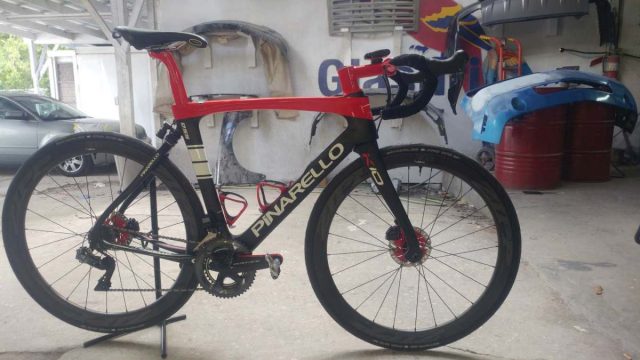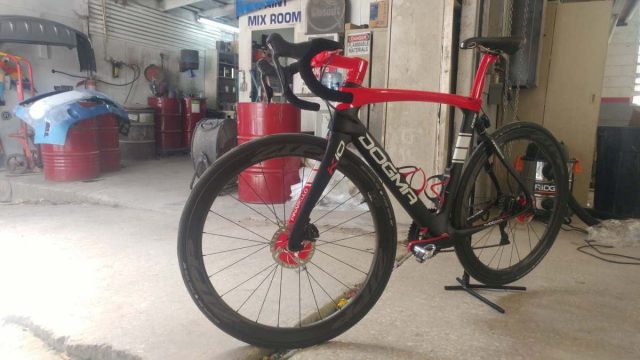Suspension has been seen adorning gravel bikes in several forms as at the time of writing this article, October of 2018. Thus far, we’ve seen forks, stems, seatposts and more controversially, a handlebar suspension system (Canyon Grail). Most of these systems have essentially been reinventions of earlier versions of suspension.
The dynamic, electronically controlled HiRide system seen adorning this Pinarello K10S Disc, which is a road bike, is intended for mitigating some of the roughness associated with gravel roads, cobblestones and other nastiness. The complete system weighs approximately 610 grams.
JOM of the Gravel Cyclist crew talks about the system present on this bike in detail, which you may be seeing more of in the future on gravel bikes?
We know of at least two prominent bike manufacturers who are tinkering with their own front and rear suspension gravel bikes at the time of this article…
Links to other suspension systems we’ve featured or reviewed on Gravel Cyclist:
- Lauf Fork
- Fox Fork
- Redshift Sports ShockStop Suspension Stem
- Niner Magic Carpet Ride Version 1
- Niner Magic Carpet Ride Version 2
- Canyon Grail
- Cirrus Cycles Kinekt Body Float Seatpost
- Redshift Sports ShockStop Suspension Seatpost
Thank you for watching!
Don’t forget to Like the Gravel Cyclist Facebook page, follow G.C. on Instagram and subscribe to our Youtube Channel.





Amazing. I’ve been riding next to Shannon for weeks and never realized what
a futuristic ride he has. Must have cost him a good couple grand.
Question:
Is there a remote control option where you scoop out your brain, install it on the bike
then simply stay at home while your body relaxes. You could cheer yourself!
HiRide’s ESAS Rear Kit weighs 320 grams!
The Pinarello seems excessively high tech. A Gravelbike with a Lauf suspension fork in the front and soft-tail suspension in the rear is more my speed—light-weight and low tech. Overall, I’m all for suspension on a Gravelbike. I like being comfortable when I’m spinning away the miles but I don’t want to add a lot of weight or complexity.
Have you seen the BMC Teamelite or the Moots YBB? Both bikes have soft-tail rear suspensions that are very low tech.
Know all about the Moots YBB, thanks for chiming in!
However, maybe suspension isn’t the answer. Maybe wider low-pressure tires are the way to go. I just took a test ride on a new 2019 Salsa Fargo that comes with 29×2.6(700×66) Maxxis Ikon tires which is a light XC-Race mountain bike tire that uses sub 20psi tire pressures. The bike rolled suprisingly fast, soaked up big hits, and was very comfortable. I believe a true Gravel tire at 29×2.6 would roll even faster and could be even lighter. Using wider tires might be an even more low tech way to add suspension—tire suspension.
I don’t disagree with the notion of wider-softer- more supple tires. All good things for all-road riding. But as a suspension system tires have very limited damping and travel compared to modern mountain bike style dual suspension systems. I learned this recently when I purchased a 2018 Specialized Fatboy to ride on local fire roads and unmaintained class 6 trails. Other than 5″ fat tires at 8 PSI, the Fatboy has a rigid carbon fork and a hard tail. Once I hit my first rock garden and got bounced around on the Fatboy, I realized that while the 5″ tires may be great in sand or mud, they can’t replace a true suspension. Tires can only go so far.
I agree that a rigid Fatbike is no substitute for a 5″ travel full-suspension mountain bike. However, using a Plus tire to get about 1″ of travel doesn’t seem unrealistic and it is help along by the huge rollover of the tall 29+ wheels. Modern Gravelbikes are looking a lot like the rigid 26er Mountainbikes of the 1980’s. I used to ride those over some pretty rough terraine. If suspension hadn’t been invented, I suspect mountain bikers would all be riding rigid 29+ bikes. Maybe Salsa is on to something? I can easily image a rigid carbon-fiber Gravelbike with light fast-rolling 29×2.6in Gravel specific tires mounted to i25mm carbon rims that weighs less than 20 pounds. I guess I just like the simplicity and low-weight of a rigid bike but I also want some comfort. Lots of people already ride rigid 29+ adventure bikes with 3.0in tires and they really like them on gravel. While most of these adventure bikes are heavy brutes, what could they be if they were supercharged by light-weight Road/Gravel technology? Maybe Gravel tires just haven’t gotten wide enough? The new Fargo is headed in that direction. Go test a Salsa Fargo and see what you think.
My concern with this type of rear suspension is that it doesn’t have antisquat. Mountain bikes put the pivot at the BB in line with the chain at the top of the chainring to avoid this. Does he find he needs to lock it out when standing to climb a steep grade for example?
Regular mode for the suspension is locked. There is no squat. Computer chooses to unlock suspension only when rough roads present a certain g-force load.
Thanks, I think this is what might make the case for this actively controlled design compared to the low-tech ones mentioned above.
I was dubious about suspension on gravel bikes. That is until I installed a Bodyfloat seat post. I was surprised at how much the Bodyfloat relieved lower back and butt pain and fatigue when riding on rough unpaved roads. It even seems to provide fatigue and pain relief on paved roads as well. Of course, the body float isn’t a bike suspension. I can only imagine how much more a true bike suspension system would improve both performance and comfort.